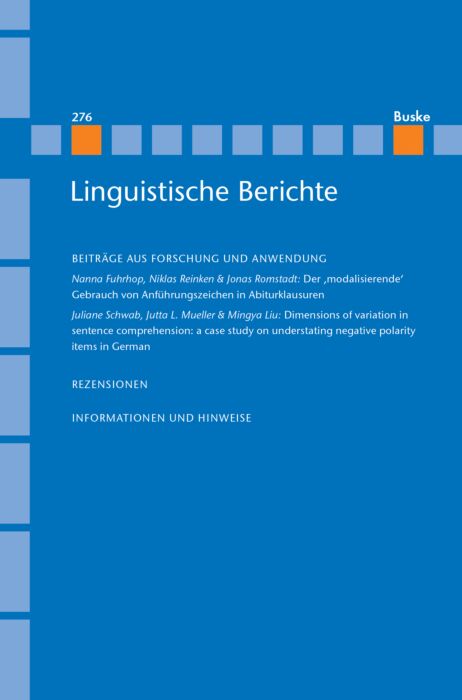Linguistische Berichte Heft 276

Beschreibung
Bibliographische Angaben
| Einband | |
|---|---|
| DOI | |
| Auflage | 1. Auflage |
| ISBN | |
| Sprache | |
| Originaltitel | |
| Umfang | 121 |
| Erscheinungsjahr (Copyright) | 2023 |
| Reihe | Linguistische Berichte |
| Herausgeber/in | Markus Steinbach Nina-Kristin Meister Günther Grewendorf Arnim von Stechow |
| Beiträge von | Sophie Ellsäßer Nanna Fuhrhop Okan Kubus Mingya Liu Jutta L. Mueller Horst M. Müller Klaus Müllner Niklas Reinken Jonas Romstadt Juliane Schwab |
| Hersteller nach GPSR |
Helmut Buske Verlag GmbH |
Service
Einzelartikel als PDF
Quotation marks are substantially used for direct speech and citations. For the ‘modalizing’ use, the Official Rules state that a “different understanding than usual” is indicated; they give very little information on the use of quotation marks beyond literal reference. It therefore seems all the more interesting to investigate the usage of modalizing quotation marks. In the present analysis, we studied the school-leaving examinations of an entire year. School-leaving examinations are texts by persons whose institutional acquisition of written language can be regarded as complete; they are texts written by skilled writers. The investigation takes into account both formal and functional observations. We recognized differences between school subjects that can be interpreted with regard to the concept of educational language. The writers described here showed a high sensitivity (conscious or unconscious) to the use of quotation marks, which we call the “struggle for educational language”. This may be related to the corpus investigated here. However, our study constitutes a solid basis for further corpus studies on quotation marks.
19,90 €
Despite the rich theoretical and empirical literature on negative polarity items (NPIs) in general, understating NPIs like all that or much have received relatively little attention in psycholinguistics. In this paper, we investigate the comprehension, processing, and production of two such understating NPIs in German, namely sonderlich ‘particularly’ and so recht ‘really’. In a first experiment, using self-paced reading and naturalness ratings, we found that sonderlich, contrary to so recht, was rated as natural in affirmative contexts although this environment is incompatible with NPIs. The finding is subsequently extended to the domain of sentence production, demonstrating that so recht was consistently used as NPI, but sonderlich was not. The last two experiments investigate the factors underlying this finding, showing that the surprising patterns for sonderlich may relate to its susceptibility for interference from form- and meaning-related lexical competitors during tasks that strain cognitive resources, and, to some extent, to individual differences in participants’ language aptitude measured through print exposure. Based on the novel empirical data, we discuss the theoretical status of sonderlich and so recht as understating NPIs, on the one hand, and the cognitive mechanisms affecting retrieval of their NPIrelated lexical-semantic features, on the other.
19,90 €
7,90 €
7,90 €
7,90 €
